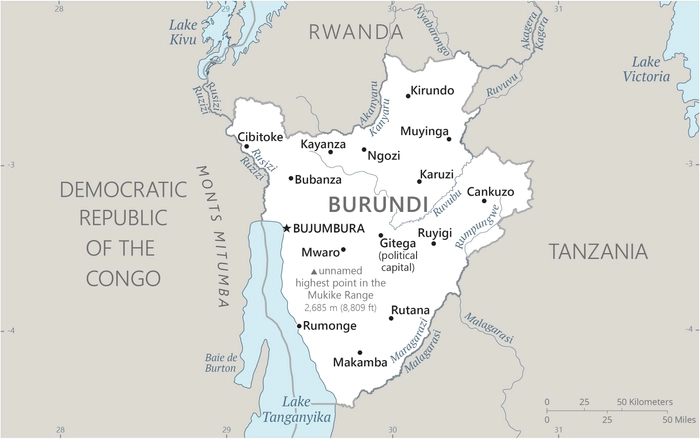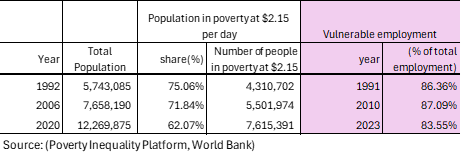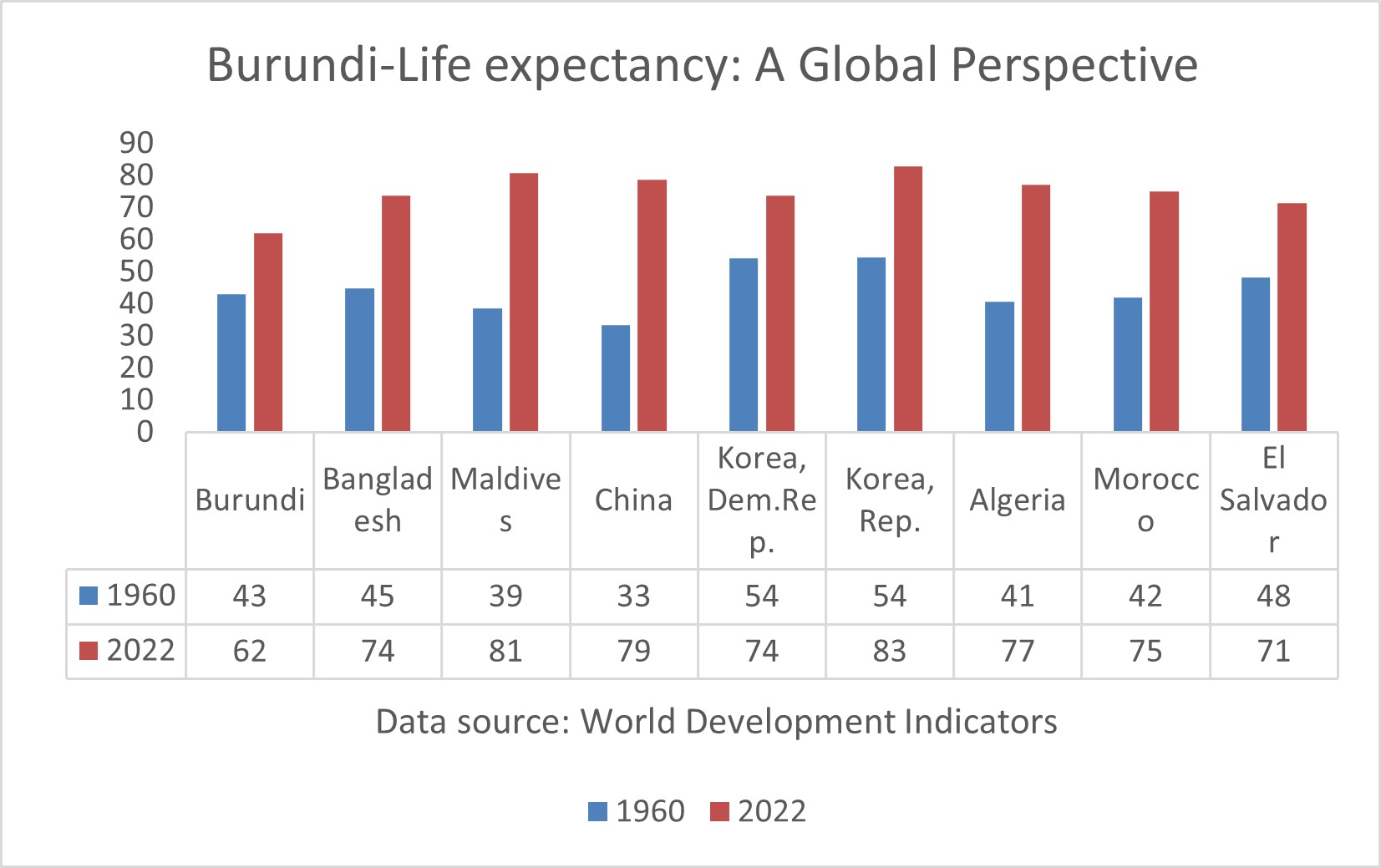
Burundi
divided by a white diagonal cross into red panels (top and bottom) and green panels (hoist side and fly side) with a white disk superimposed at the center bearing three red six-pointed stars outlined in green arranged in a triangular design (one star above, two stars below); green symbolizes hope and optimism, white purity and peace, and red the blood shed in the struggle for independence; the three stars in the disk represent the three major ethnic groups: Hutu, Twa, Tutsi, as well as the three elements in the national motto: unity, work, progress.
Background
Burundi gained its independence from Belgium in 1962 as the Kingdom of Burundi, but the monarchy was overthrown in 1966 and a republic established. The assassination of Burundi’s president in 1993 triggered 12 years of ethnic violence between Hutu and Tutsi factions. Political violence and non-democratic transfers of power have marked much of Burundi’s history.

Geography
Area
total : 27,830 sq km
land: 25,680 sq km
water: 2,150 sq km
Climate
equatorial; high plateau with considerable altitude variation (772 m to 2,670 m above sea level); average annual temperature varies with altitude from 23 to 17 degrees Celsius but is generally moderate; average annual rainfall is about 150 cm with two wet seasons (February to May and September to November) and two dry seasons (June to August and December to January)
Natural resources
nickel, uranium, rare earth oxides, peat, cobalt, copper, platinum, vanadium, arable land, hydropower, niobium, tantalum, gold, tin, tungsten, kaolin, limestone
People and Society
Population
total: 13,590,102
Ethnic groups
Hutu, Tutsi, Twa, South Asian
Languages
Kirundi (official), French (official), English (official, least spoken), Swahili (2008 est.)
Religions
Christian 93.9% (Roman Catholic 58.6%, Protestant 35.3% [includes Adventist 2.7% and other Protestant religions 32.6%]), Muslim 3.4%, other 1.3%, none 1.3% (2016-17 est.)
Population growth rate
2.81% (2024 est.)
Government
Government type
presidential republic
Capital name: Gitega (political capital), Bujumbura (commercial capital)
Executive branch
chief of state: President Evariste NDAYISHIMIYE (since 18 June 2020)
head of government: Minister Gervais NDIRAKOBUCA (since 7 September 2022)
Economy
Economic overview
highly agrarian, low-income Sub-Saharan economy; declining foreign assistance; increasing fiscal insolvencies; dense and still growing population; COVID-19 weakened economic recovery and flipped two years of deflation
Real GDP (purchasing power parity)
$11.347 billion (2023 est.)
$11.048 billion (2022 est.)
$10.848 billion (2021 est.)
Real GDP per capita
$800 (2023 est.)
$800 (2022 est.)
$800 (2021 est.)
Exports
$378.229 million (2023 est.)
$333.637 million (2022 est.)
$302.752 million (2021 est.)
Exports – partners
UAE 59%, Uganda 8%, China 5%, Germany 5%, USA 3% (2023)
Exports – commodities
gold, coffee, tea, tin ores, iron bars (2023)
Imports
$1.433 billion (2023 est.)
$1.42 billion (2022 est.)
$1.166 billion (2021 est.)
Imports – partners
Tanzania 26%, China 15%, Uganda 10%, Kenya 10%, India 6% (2023)
Imports – commodities
fertilizers, cement, packaged medicine, plastic products, cars (2023)

Export structure by product group in 2023 (% of total exports) (UNCTAD)
The export structure of a nation constitutes a critical framework that reflects the diversity, composition, and economic value of the goods and services it engages in on the international stage, thereby providing significant insights into the nation’s economic health, competitive standing, and developmental trajectory. In the case of Burundi, the export structure is notably marked by a pronounced reliance on a limited array of commodities, with coffee, tea, and gold being the predominant exports. The ongoing diversification initiatives, particularly within the agricultural sector, offer promising pathways to enhance the resilience and robustness of Burundi’s export economy.

Poverty and vulnerable employment in Burundi
In 2023, a staggering 84 percent of total employment in Burundi was classified as vulnerable employment, a term that denotes work characterized by inadequate job security, low wages, and a significant absence of essential social protections, such as health insurance, pensions, or labor rights. This category predominantly encompasses own-account workers, individuals who are self-employed and do not employ others, exemplified by street vendors and small-scale farmers, as well as contributing family workers, who participate in family-run enterprises without receiving formal remuneration. The nature of these jobs is frequently informal and unstable, devoid of benefits, thereby rendering workers particularly vulnerable to economic fluctuations, potential exploitation, and persistent poverty. The ramifications of such employment extend beyond the individual, affecting families and broader communities, perpetuating cycles of instability and hardship that are difficult to transcend.
Understanding poverty level significance at $2.15 per day
In 2020, 62 percent of the population in Burundi lived in Poverty at $2.15 per day. The poverty level at $2.15 per day (measured in 2017 purchasing power parity, or PPP) is a key global benchmark used by the World Bank to define extreme poverty in low-income countries. It indicates:
1. Basic Survival Threshold
• People living below $2.15 per day struggle to afford essential needs such as food, clean water, shelter, healthcare, and education.
2. Economic Underdevelopment
• A high percentage of a country’s population living below this threshold suggests low economic productivity, high unemployment, and weak social safety nets.
3. Inequality and Social Vulnerability
• It reflects deep income inequality and a lack of access to opportunities for upward mobility.
• People in this category are more vulnerable to shocks like food price increases, climate disasters, or health crises.
4. Policy Challenges
• Governments need targeted interventions such as social welfare programs, job creation, and improved access to education and healthcare to reduce poverty.
A country's export structure is a reflection of its level of development and productive capacities
The export structure of a country refers to the composition, diversity, and value of the goods and services it sells to other countries. It provides key insights into the country’s economic health, competitiveness, and level of development. Productive capacities of a country refer to its ability to produce goods and services efficiently and sustainably over time. These capacities are shaped by various factors, including human capital, natural resources, infrastructure, private sector, development, technology & innovation, institutions & governance, financial systems trade & market access.
Here’s what the export structure and productive capacities of a country typically indicate:
- Level of Economic Development
- Developed economies usually export high-value manufactured goods, technology, and services.
- Developing economies often rely on raw materials, agricultural products, or low-value manufactured goods.
- Industrial and Sectoral Strengths
- A strong presence of high-tech or industrial goods (e.g., machinery, electronics) suggests a well-developed manufacturing sector.
- A dominance of commodities (e.g., oil, minerals, agricultural products) indicates reliance on natural resources.
- Export Diversification
- A diverse export base (multiple industries) makes a country’s economy more stable and resilient to global price shocks.
- A concentrated export base (few key products) makes it vulnerable to market fluctuations.
- Trade Partnerships and Dependence
- If exports are heavily dependent on a single country or region, the economy is more exposed to geopolitical and trade risks.
- A wide range of trading partners indicates stronger global integration.
- Competitiveness and Value Addition
- Exporting mainly raw materials (e.g., crude oil instead of refined petroleum) suggests limited industrial processing capacity.
- A high share of finished and high-tech goods suggests strong value addition and competitiveness.
Burundi-Sanitation
Burundi – Proportion of population served with at least basic sanitation
In 2022, proportion of population served with at least basic sanitation for Burundi was 45.7 %. Proportion of population served with at least basic sanitation of Burundi increased gradually from 45.2 % in 2000 to 45.7 % in 2022, an absolute change of 0.5 percentage points (pp) between 2000 and 2025
Burundi – Proportion of urban population served with at least basic sanitation
In 2022, proportion of urban population served with at least basic sanitation for Burundi was 41.2 %. Proportion of urban population served with at least basic sanitation of Burundi increased gradually from 40.6 % in 2000 to 41.2 % in 2022, an absolute change of 0.6 pp between 2000 and 2022.
Burundi – Proportion of rural population served with at least basic sanitation
In 2022, proportion of rural population served with at least basic sanitation for Burundi was 46.4 %. Proportion of rural population served with at least basic sanitation of Burundi increased from 45.6 % in 2000 to 46.4 % in 2022, an absolute change of 0.8 pp between 2000 and 2022.
Burundi – Proportion of population served with at least basic sanitation: A Global Perspective
The lack of safe sanitation presents a profound challenge that requires immediate collective action, resulting in preventable deaths for hundreds of thousands each year and highlighting a serious public health crisis. Access to safe sanitation is not just a necessity; it is a fundamental human right that must be guaranteed to everyone. In 2022, around 7 million people, or nearly 54 percent of Burundi’s population, suffered from inadequate sanitation facilities, in stark contrast to countries like Vietnam, China, and Thailand, which reported only 8 percent, 5 percent, and 1 percent lacking these essential services respectively. The global average of individuals without adequate sanitation is approximately 6 percent, underscoring the urgent need for collaborative efforts to improve sanitation access in underserved regions of Sub-Saharan Africa.

Burundi – Proportion of rural population served with at least basic sanitation: A Global Perspective
In 2022, around 6 million people in rural Burundi, or about 54 percent of the population, lacked access to basic sanitation facilities, contrasting sharply with countries like Vietnam, Sri Lanka, and Thailand, where the figures were just 12 percent, 5 percent, and 2 percent respectively. The absence of safe sanitation is not only an urgent challenge but also a troubling reality that requires our immediate compassion, as it contributes to countless lives lost each year, intensifying a critical public health crisis that necessitates prompt action. Safe sanitation is more than a necessity; it is a fundamental human right that everyone deserves. Therefore, we must unite in solidarity to advocate for this essential right throughout Sub-Saharan Africa, where the need is pressing and the potential for transformative community change is vital for the dignity and well-being of all.

Burundi-Water Supply
Burundi – Proportion of total population served with at least basic water
In 2022, proportion of population served with at least basic water for Burundi was 62.4 %. Proportion of population served with at least basic water of Burundi increased from 50.7 % in 2000 to 62.4 % in 2022 , an absolute increase of 11.7pp between 2000 and 2022.
Burundi – Proportion of urban population served with at least basic water
In 2022, proportion of urban population served with at least basic water for Burundi was 90.7 %. Proportion of urban population served with at least basic water of Burundi increased from 82 % in 2000 to 90.7 % in 2022 an absolute increase of 8.7 pp b between 2000 and 2022.
Burundi – Proportion of rural population with at least basic water
In 2022, proportion of rural population served with at least basic water for Burundi was 57.7 %. Proportion of rural population served with at least basic water of Burundi increased from 47.8 % in 2000 to 57.7 % in 2022 an absolute increase of 9.9 pp between 2000 and 2022.
Burundi – Proportion of total population served with at least basic drinking water: A Global Perspective
Access to safe drinking water is a fundamental human right requiring immediate and collective action globally. In 2022, nearly 5 million people in Burundi, about 38% of the population, were without this essential resource, revealing a critical public health crisis that demands our attention. In contrast, everyone in Thailand and 98% of people in Vietnam and Bangladesh had reliable access to safe drinking water that same year. This stark inequality highlights the urgent need for transformative reforms in Sub-Saharan Africa, where many still lack the resources necessary to improve their quality of life. We must strengthen our efforts to ensure that every person has access to safe drinking water, as fulfilling this right is a moral obligation we hold as a global community.

Burundi – Proportion of rural population served with at least basic drinking water: A Global perspective
In 2022, it is alarming that 42% of Burundi’s rural population, or about 4.7 million people, lacked access to safe drinking water, revealing a severe humanitarian crisis that requires urgent attention. In contrast, countries like Thailand, Bangladesh, and Vietnam have achieved nearly universal access to this vital resource, with 100%, 98%, and 97% of their rural populations, respectively, benefiting from safe drinking water. This stark inequality highlights the significant governance challenges in many Sub-Saharan African nations and underscores the need for coordinated efforts and collective action to improve living conditions and ensure essential resources for the most vulnerable communities.

Burundi- Electricity
Burundi-Access to electricity (% of population)
In 2022, proportion of population with access to electricity for Burundi was 10.3 % in 2022. The proportion of population with access to electricity of Burundi increased from 2.5% in 2000 to 10.3% in 2022, an absolute change of 7.8 pp between 2000 and 2022.
Burundi-Access to electricity (% urban population)
In 2022, proportion of urban population with access to electricity for Burundi was 64%. The proportion of urban population with access to electricity of Burundi increased from 49.6% % in 2000 to 64% in 2022, an absolute change of 14.4 pp between 2000 and 2022.
Burundi-Access to electricity (% of rural population)
In 2022, proportion of rural population with access to electricity for Burundi was 1.7 %. The proportion of rural population with access to electricity of Burundi increased from 1.2 % in 2000 to 1.7% in 2022, an absolute change of 0.5 pp between 2000 and 2022.
Burundi- Proportion of total population with access to electricity: A Global perspective
In 2022 nearly 89.7% of the population in Burundi lived without access to electricity reflecting a critical crisis that leaves over 11 million people without this essential service vital for their daily lives. This stark reality contrasts with countries like Vietnam and Thailand which have achieved universal electricity access underscoring the urgent need for systemic reforms in Sub-Saharan Africa to improve living conditions. The lack of reliable electricity threatens development health education and economic opportunities all essential for raising living standards and fostering hope for a sustainable future in Burundi.

Burundi-Proportion of rural population with access to electricity (% of rural population)
In 2022, an alarming 98.3 percent of the rural population in Burundi faced the harsh reality of living without electricity, highlighting a significant disparity compared to countries like Vietnam, Thailand, and Sri Lanka, where all rural residents enjoy access to this critical resource. Even nations such as India and Bangladesh have 99 percent of their rural populations benefiting from reliable electricity. These statistics illustrate the urgent need for transformative governance reforms across Sub-Saharan Africa to ensure that every community has dependable access to electricity and is empowered to pursue a sustainable and prosperous future.

Burundi: Health Outcomes
Burundi-Life expectancy: A Global Perspective
As we explore life expectancy trends over the past seven decades, it becomes clear that although humanity has made significant advancements resulting in longer and healthier lives, stark disparities persist, particularly in Sub-Saharan Africa. The global average life expectancy for newborns has risen from 47 years in 1950 to 71 years by 2021, yet progress in many Sub-Saharan African nations remains limited. For instance, Burundi’s life expectancy increased from 43 years in 1960 to 62 years in 2022, revealing ongoing challenges faced by its population. In contrast, countries like South Korea saw life expectancy rise dramatically from 54 years in 1960 to 83 years by 2022, while the Maldives improved from 39 years in 1960 to 81 years in 2022. The low life expectancy in several Sub-Saharan African nations highlights the pressing issues they face, including chronic poverty and inadequate healthcare systems, underscoring the urgent need for transformative actions to foster a sustainable and equitable future for these communities.

Burundi- Under-5 mortality rate (per 1000 live births): A Global Perspective
Since 1950, child mortality rates globally have significantly declined, largely due to enhancements in living standards, healthcare, nutrition, and access to safe drinking water. In Europe and America, rates have fallen below 4 percent, showcasing the impact of robust healthcare systems and socioeconomic stability. While many developing nations in South America, Asia, and Africa have made notable progress, Sub-Saharan Africa still faces slow advancements. For instance, Burundi’s under-five mortality rate dropped from 170 in 1980 to 51 in 2022. Bangladesh and India have both achieved impressive reductions, with rates decreasing from 206 and 169 in 1980 to 29 in 2022, respectively. These figures reveal persistent challenges due to inadequate healthcare and emphasize the urgent need for structural reforms in governance in Sub-Saharan Africa to combat child mortality and enhance health outcomes for vulnerable populations, highlighting the critical role of international collaboration and investment in sustainable health initiatives.

Burundi-Maternal mortality ratio (per 100,000 live births): A Global Perspective
Burundi’s maternal mortality ratio has significantly decreased from 874 in 2000 to 494 in 2020, yet this figure remains alarmingly high, reflecting serious challenges and risks faced by mothers nationwide. Although this progress is noteworthy, it starkly contrasts with the much lower ratios in Bangladesh, India, and Vietnam, which reported 123, 103, and 46 in 2022 respectively. These distressing figures illustrate the ongoing crisis of pregnancy-related deaths in Burundi, compounded by high birth rates and persistent maternal health issues that require urgent action. The concerning statistics highlight critical weaknesses in the healthcare system and point to systemic underfunding across Sub-Saharan Africa. The significant disparities in maternal health outcomes compared to other developing regions emphasize the urgent need for substantial investments in health infrastructure and resources, as the lives of mothers and their children in Burundi remain at dire risk, an unacceptable and preventable situation.
